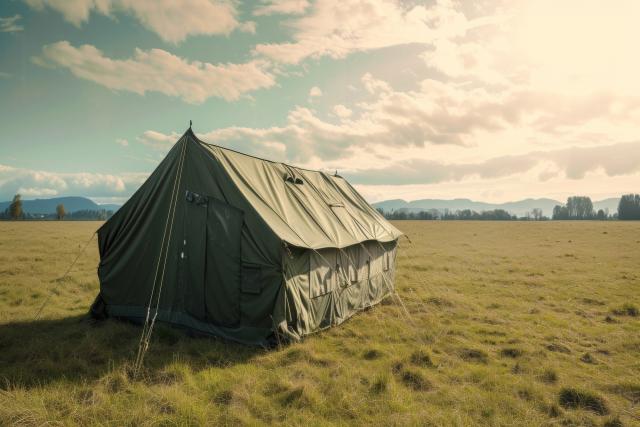
Getting maintenance and repairs done properly out in the field is a lot easier when you have a good workspace set up. Portable shelters, also called maintenance enclosures, offer some major upsides over working outdoors exposed to the elements. Let's dive into why these lightweight, mobile structures are gaining popularity across many industries.
What Are Maintenance Enclosures?
A lightweight maintenance enclosure is basically a temporary, portable workspace that can be easily transported and assembled wherever needed. Picture a tent or shelter designed specifically for completing maintenance tasks, repairs, or service work.
These shelters are made from durable tent frame materials like aluminum, with a weather-resistant fabric shell covering the structure. Despite being lightweight and mobile, they provide a controlled environment shielded from rain, snow, wind, and other harsh conditions.
Improved Workspace Conditions
Working outdoors on equipment or machinery, you're at the mercy of whatever weather happens to be going on that day. Bad weather like freezing temperatures, scorching heat, rain or snow, and strong winds can really mess up how well the work gets done, as well as put people's safety at risk and make the end result not as good.
How many times have you had to reschedule outdoor maintenance because of a surprise rainstorm or blizzard?
With a portable and lightweight shelter set up, you instantly upgrade to a much more hospitable workspace. The enclosed environment blocks wind, rain, and snow while allowing temperature control and adequate lighting. This creates an ideally comfortable setting to complete maintenance and repairs properly.
Portability For Remote Jobsites
Traditional shelters or buildings intended as maintenance facilities are permanent structures. If work needs to be done out in a remote location away from the shop, you're stuck working outdoors.
Maintenance enclosures are designed to be quickly transported wherever needed, even to rural or hard-to-access areas. The lightweight aluminum framing and fabric shell allow these shelters to be easily loaded into trucks or trailers.
Once you get the lightweight shelter to where you need it, you can move it around using a forklift or small crane if you have to. Setup and teardown are straightforward, expanding your options for productive field maintenance.
Contamination Control
For work on sensitive equipment or in cleanroom environments, contamination from dust, dirt, and debris is a major concern. Trying to service parts and components while exposed to the open air significantly increases contamination risks.
An enclosed shelter creates a contamination control workstation, giving you a proper, clean space for precision maintenance.
Many lightweight shelter models are available with integrated craning systems, allowing larger parts and machinery to be carefully maneuvered inside while minimizing contamination exposure.
Built For Your Industry
While the core benefits apply across sectors, maintenance shelters are designed with specific industry applications in mind:
Aviation Aerospace
Customized enclosures for aircraft maintenance, painted interior linings to reduce particulate levels, integrated fall protection equipment anchors, and more.
Industrial Manufacturing
Shelters are configured for machinery repair and servicing, with translucent roof panels for natural lighting and integrated crane systems.
Military and Defense
Highly mobile shelters built to military specifications, with blackout options, chemically resistant liners, and capacity for NBC (nuclear/biological/chemical) filtration.
Whether for aviation, manufacturing, or military/defense, these portable structures provide an optimized space tailored for your equipment maintenance needs.
Safety Enhancements
Working outdoors exposes technicians to hazards like slippery surfaces, extreme temperatures, falling debris, and more. An enclosed shelter significantly reduces many of these risks.
Integrated craning and fall protection allow for safer handling of heavy components. Temperature control prevents heat illness or freezing conditions. The shelter physically separates the workspace from surrounding hazards.
Anti-slip flooring, proper lighting levels, and accessory additions like decontamination entry rooms all contribute to an overall safer working environment compared to exposed outdoor conditions.
Pro-environment
There are 'green' benefits to using portable maintenance shelters as well. Containing all work within an enclosed space prevents pollution from spills, leaks, or debris blowing away and contaminating the surrounding area.
Hazardous materials can be better controlled and disposed of properly. Noise pollution is reduced by containing noisy activities within the shelter walls. These measures help minimize the environmental impact of tactical maintenance operations.
Cost Effectiveness
While they can be costly at first, but these shelters will yield ROI over time.
Avoiding project delays and rescheduling due to weather minimized expensive downtime and missed deadlines.
Proper environmental controls prevent costly contamination incidents or work delays. Increased technician safety reduces injury risks and liabilities.
Shelters have a long usable lifespan and can be relocated and reused repeatedly. In the long run, getting more work done at a higher quality by using these shelters will easily make up for the money you spent on them.
Upgrading Your Tactical Maintenance Operations
From contamination control to environmental protection, productivity enhancements to improved safety – lightweight and mobile maintenance shelters take your maintenance capabilities to the next level.
Choose the one that fits your needs. Don't let less-than-ideal outdoor conditions compromise your maintenance work any longer!






